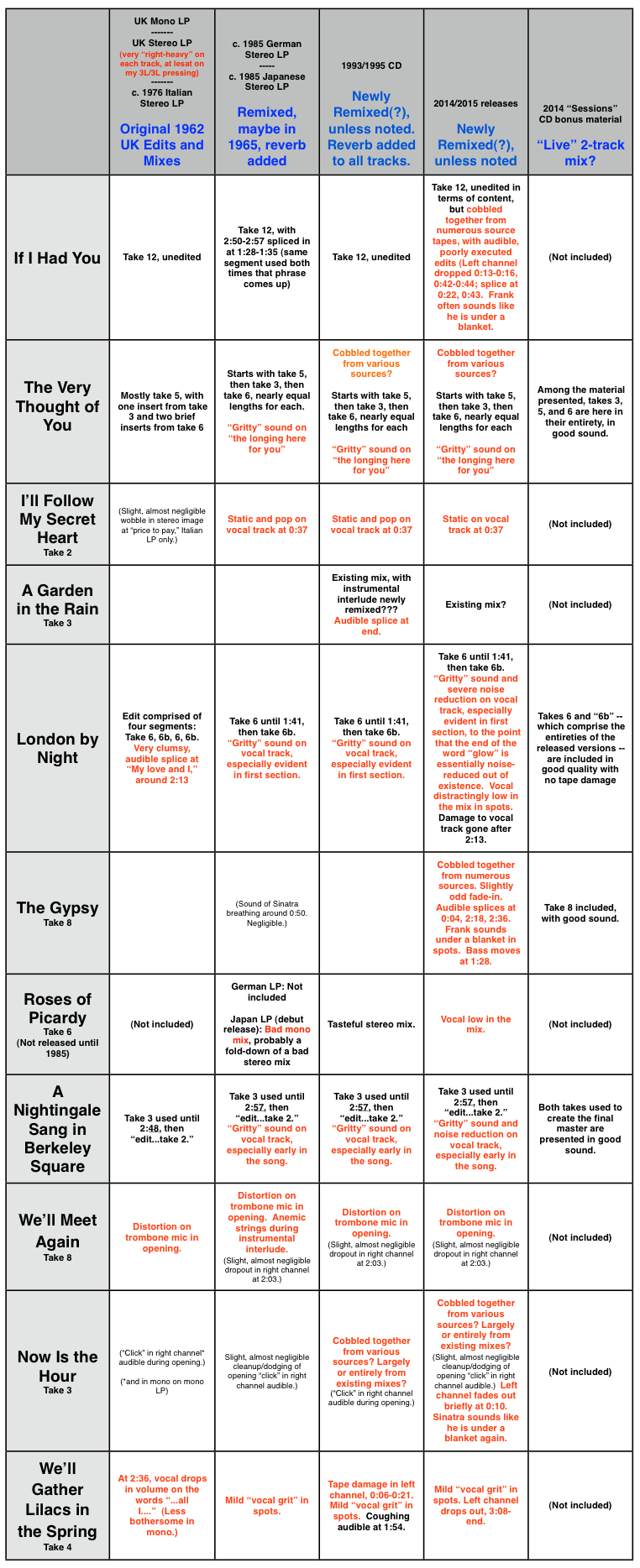Sinatra Sings Great Songs from GREAT BRITAIN - 1962

For those of you who are, like I am, old enough to remember the old days, you will recall that virtually all of the Sinatra catalogue titles on Reprise were just about “permanently in-print” through the LP years, roughly 1961-1987. They were, by-and-large, always available. Album 1006, though, was, more often than not, unavailable, sometimes for many years in succession, and it was never available on LP in the USA. Perhaps it was the use of a British studio; perhaps it was the involvement of Pye Records in the UK; perhaps it was the chain of custody that the tapes went through over the years; perhaps it was the type of tape stock used; perhaps it was the condition of whatever “vaults” (or old theatres or Bekins units) were used for storage -- WHATEVER the reason, there are tape source gremlins that permeate the release history of this album. That being said, to merely listen to a random 45-second clip of a song or two will not give an accurate idea of what is good or bad about any of the very few available releases, so a different approach must be taken, and so it is that we will be looking at each track, in order recorded, looking not just at overall sound quality, but also at what problems, defects, splices, and audible distractions occur on which versions.
The released editions of this album have been intriguingly problematic. Let’s look at “the weirdness” that has gone on.
A Look at “The Weirdness” of Releases through the years

How “weird” is some of this stuff? Please indulge me while I tell a true little story about the Japanese LP clips that ArneW sent. I bought the same Japanese LP release years ago, and I had literally never played it, not even a single song. It has just been sitting in my record collection, untouched. A few months ago, Arne kindly sent along some stuff for me to hear, and the Japanese LP tracks that he sent, upon initial listen, sounded SO WEIRD that I thought there must be a problem with Arne’s (usually reliable) LP transfer process, so I dug out my identical Japanese LP, put it on my turntable, and it sounded IDENTICAL to Arne’s transfer. In other words, his transfer was, from a technical standpoint, excellent, but that Japanese LP has some issues! That’s par for the course regarding this album.
Here’s a rundown of what is compared in the chart below:
•Original UK R-1006 mono LPs, manufactured by Pye Records (Thank you, BFerr1 and Pieter Kozak)
•Original UK R9-1006 stereo LP, manufactured by Pye Records
•Circa 1976 Italian “Sinatra in London” stereo LP
•Circa 1985 Japanese stereo LP (poor-quality remix and new edits)
•Circa 1985(?) German stereo LP (same poor-quality remix and new edits as Japanese LP)
(NOTE: To my knowledge, the above releases represent the only pre-2015 LP releases in each of those countries. As mentioned, the album was rarely in print.)
•1993/1995 CD release, mastered by Lee Herschberg, largely remixed? Some edits follow the UK release; some the Japanese/German release
•2014/2015 UMe releases (HD, LP, CD) - all sourced from a newly-created digital master, cobbled together from various sources, with a mix of edits and many technical deficits. As a matter of course, all three 2014/2015 releases sound very similar to one other. (Thank you, BFerr1).
As mentioned on page one, as much as I love minutiae and “detail” stuff, even I started to doze off reading all the little details, so I have tried to summarize things in this handy chart:


...but what to make of all this? What are the take-aways?
Where do I start?
-
1.Looking over the “problem areas” (in red), it’s apparent that the original UK and 2014 “Sessions” bonus materials are sourced from different and superior tapes than all other versions, possibly sourced from “live mix” stereo tapes made during the sessions by engineer Eric Tomlinson.
-
2.The remixed releases are the ones with the technical problems, by and large. (Usually, if an album is remixed, that task is undertaken to SOLVE problems, real or imagined. In this case, the remixes have ADDED problems.)
-
3.The SAME problems keep cropping up on all the remixes, indicating that the “problems” stem not from the new mix, but on the 3-track tape from which the new mixes are being made.
-
4.For some of the “remixed” versions of certain tracks, I’m not 100% sure that we are actually hearing remixes, indicating that there MAY be additional tape
source issues, i.e., aging,
missing, or damaged tape.
(“MAY” is the key word.)
BELOW: Edit Differences for “The Very Thought of You”
BELOW: Edit Differences for “London by Night”

“If I Had You” and “A Nightingale Sang in Berkeley Square” also have differing edits on some versions. See the large song-by-song chart earlier on this page.

Note, too, that there are actually two blue patches on the UK grid, with just a sliver of green between them. The first blue patch is nearly a complete measure of music leading into Frank’s re-entry after the instrumental passage. The green sliver that follows is very odd. It is literally just the start of the word “I” (as in, “I see your face....”). Part of the word “I” that follows the vocal scoop comes from take 6. Why was take 6 used here? Frank’s voice cracked during the word “face” in take 5. That second blue patch, then, covers “I see your face in every,” and then on “flower,” we are back to take 5 again.
